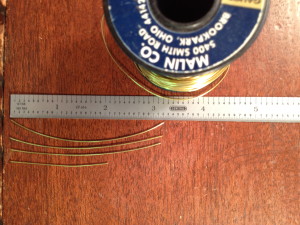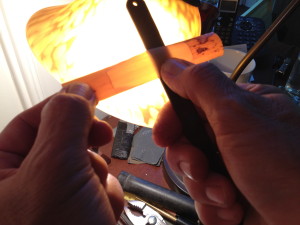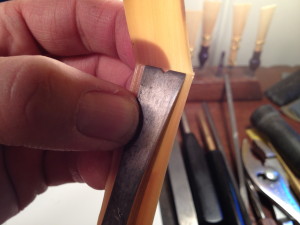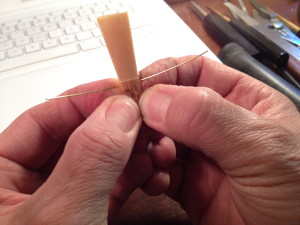Forming the cane is done after it has been gouged, profiled and shaped.
 1. Soak the cane overnight, 10-12 hours, or longer; until saturated (cane will sink to bottom).
1. Soak the cane overnight, 10-12 hours, or longer; until saturated (cane will sink to bottom).
 Cut 3 pieces of wire about 4 inches, one piece 2 inches. Set aside. Soak wrapping string. We use cotton boxing string.
Cut 3 pieces of wire about 4 inches, one piece 2 inches. Set aside. Soak wrapping string. We use cotton boxing string.
2. Score the bark.
Place cane on easel.
Use reed knife:
Cut short middle line (1/8″ inch) [an optional refinement, not standard]
Divide each half with 3 long cuts from 1st wire to bottom of tube
[Total: 6 long cuts, 1 tiny cut on each bark side.]
 3. Bevel.
3. Bevel.
Bevel the edges inside of tube from half way to bottom. Use 320 paper or knife.
Take off pointy edge getting more flat toward bottom.
 4. Fold cane.
4. Fold cane.
Bend from middle of the blade carefully to fold
If cane doesn’t fold evenly you can with knife lightly trace fold line so it will bend with little resistance. Line up blade edges to the beginning of the bark.
 5. Place 1st wire.
5. Place 1st wire.
Measure from bottom of tube up 1 1/16″ and place wire.
6. Wrap wet string tightly from middle of blade to bottom of tube and back up to middle of cane.
______________________________________________________________________
7. Form tube. With pliers in open position gently ease the bottom of tube to open. Glide long mandrel into tube slowly while crushing tube end with pliers.
8. Place 2nd wire. Unwrap string enough to place 2nd wire 5/16″ below 1st wire.
9. Place 3rd wire. Remove string and place 3rd wire 1/4″ from bottom of tube.
10. Place 4th wire (temporary). Place as close to bottom as possible to prevent end of tube from spreading.
11. Dry on mandrel or drying pegs for 3 days minimum (wires will become very loose).
Leave a Reply